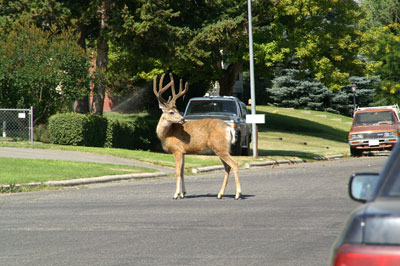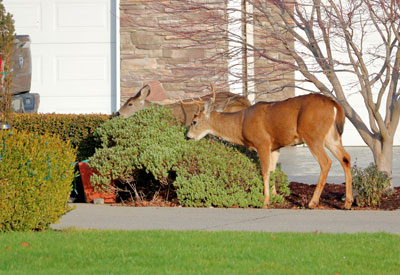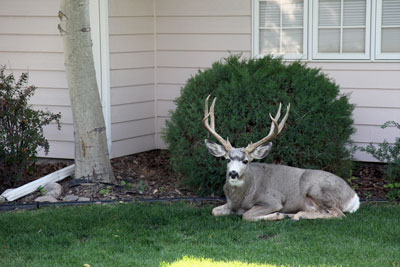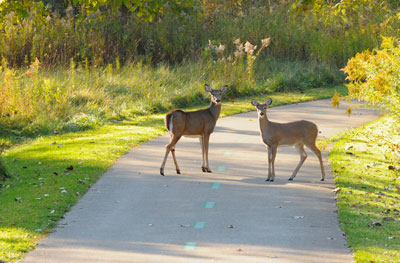




Deer can cause several types of problems in residential settings, from personal property damage and crop destruction to expensive car/deer accidents. The most common complaint is deer damage to vegetable gardens, fruit trees, and ornamentals. It is not easy or cheap to keep unwanted deer away, and often the best solution may be a greater understanding and tolerance of deer.
The deer were here first; they have been displaced from their natural habitats by man, and are now living around our homes and towns. Deer are creatures of habit. They may visit the same food sources and select the same cover to hide in every day, unless humans or other predators interrupt these patterns. Deer are highly adaptive; they soon learn that a dog is on a chain or fenced, that scarecrows are not so scary, that repellents are not really that bad, short fences are easy to jump, and holes and gaps in fences are easy to find.
Not only is it illegal, but feeding deer can render them dependent upon artificial food sources, attract mountain lions, result in deer-caused damage on neighboring properties, increase deer/car collisions, and you could be held legally liable for any problems or damage caused by the deer on neighboring property.
A person may not provide supplemental feed attractants to game animals by purposely or knowingly providing supplemental feed attractants in a manner that results in an artificial concentration of game animals that may potentially contribute to the transmission of disease or that constitutes a threat to public safety.
To keep deer out, you must be consistent in your efforts. Remember that when deer numbers increase and when food becomes scarce, deer may eat plants that they otherwise avoid, ignore repellents, and overcome their fear of scare devices. No single technique may work for keeping deer out of your yard all of the time. It is recommended that you use a combination of methods for best results.
A free-roaming dog within a fenced yard is a strong deterrent. If you are not crazy about having a traditional fence, the buried "invisible fence" cables with an electronic dog collar are effective. With the invisible fence, you do not have a fence to look at or to mow around; your dog stays in the yard, and hopefully the dog keeps the deer out. Because deer visit yards at night, it is important that the dog have access to the yard at all hours.
There are many deer repellents on the market and more coming out all the time. However, many of these have proven to be unsatisfactory. Some are only effective for light to moderate deer problems. Many do not last long and are ignored during periods of high deer concentration. Other repellents are easily washed away by rain or watering and require constant reapplication. Some of the repugnant repellents not only keep deer out of the yard, they keep you out as well. Check with your local nursery and see what has proven effective in your area. Ivory soap shaved over and around smaller plants, such as tulips and many annuals, has proven effective as long as you can see the soap.
Fencing is the most effective deterrent for deer around gardens and yards. Deer can easily jump a 5′ fence, many can clear a 6′ fence, some a 7 footer, and a very few can even jump an 8′ fence. Deer have also been known to “broad jump” streams up to 14′ wide. The good news is that deer cannot high jump and broad jump at the same time. Deer resist jumping over something if they cannot see the landing site. Knowing these behavioral traits, you can design your fence to outwit unwelcome deer.
Fences can be costly since they need to be at least 7′-8′ high. An 8′ fence is the most expensive, but it is probably the most effective. New on the market are heavy plastic prefabricated deer fencing materials. They are heavier than the standard garden bird netting and are usually 7′-8′ tall. Being rather opaque, they blend into a variety of backgrounds, and many times all you see are the upright posts. These are durable, long-lasting fences.
Double row fences 5′ high and 4′-5′ apart will keep the deer from doing the simultaneous high jump and broad jump. A variation of this is a 5′ high fence with wire that slants at a 30 degree angle for about 4′-5′ along the ground.
Electric fences are not as costly as most traditional 7′ or 8′ fences. For the best results, place the wire 18″ or more off the ground. To prevent some deer from learning to jump over this single strand, place a second wire 40″ off the ground. It is recommend that you use a voltage of 4,000 or higher. To introduce the deer to the electric fence, it is recommended that you attract them to it with peanut butter. One method is to hang aluminum foil strips smeared with peanut butter on the wire. When deer come to lick the peanut butter, they receive a jolt to the nose and mouth and learn their lesson.
It is possible to landscape with plants that deer do not normally feed upon. However, during periods of high deer densities, during severe winters, and food shortages in other seasons, deer may resort to eating less favored plant species. Consult your nursery for information on deer-resistant species that thrive in your vicinity.
Individual plants may be protected with nylon or wire fencing installed immediately around the plant. Make a cylinder or square enclosure around the plant and anchor it well to the ground. This works well with fruit trees if the fence material is installed 3'-5' from the plant and attains a height of 5'. This allows the tree to grow to full maturity without major deer damage. After the tree grows large and tall enough, the fence can be removed.
Deer Proofing Your Yard & Garden. 1997. Rhonda Massingham Hart. Storey Books. Pownal, VT.
Outwitting Deer. 1999. Bill Adler, Jr. Lyons Press. NY, NY.
Prevention and Control of Wildlife Damage. 1994. Cooperative Extension Division. Institute of Agriculture and Natural Resources. University of Nebraska, Lincoln, NE.
Wild Neighbors The Humane Approach to Living with Wildlife. 1997. John Hadidian, Guy Hodge and John Grandy, eds. The Humane Society of the United States. Washington, D.C.
